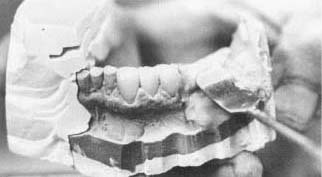Since antiquity, the most common material for false teeth was animal bone or ivory, especially from elephants or hippopotami. Human teeth were also used, pulled from the dead or sold by poor people from their own mouths. These kinds of false teeth soon rotted, turning brown and rancid. Rich people preferred teeth of silver, gold, mother of pearl, or agate. In 1774 the French pharmacist Duchateau enlisted the help of the prominent dentist Dubois de Chemant to design hard-baked, rot-proof porcelain (a hard, white ceramic) dentures. De Chemant patented his improved version of these "Mineral Paste Teeth" in 1789 and took them with him when he emigrated to England shortly afterward. The single porcelain tooth held in place by an imbedded platinum pin was invented in 1808 by the Italian dentist Giuseppangelo Fonzi. Inspired by his dis-like of handling dead people's teeth, Claudius Ash of London, England, invented an improved porcelain tooth around 1837. Porcelain teeth came to the United States in 1817 via the French dentist A. A. Planteau. The famous American artist Charles Peale (1741-1847) began baking mineral teeth in Philadelphia, Pennsylvania, in 1822. Commercial manufacture of porcelain teeth in the United States was begun, also in Philadelphia, around 1825 by Samuel Stockton. In 1844 Stockton's nephew founded the S. S. White Company, which greatly improved the design of artificial teeth and marketed them on a large scale. Porcelain is no longer used because better materials have been developed. Today, dentures are made from either plastic or ceramic. These materials can be tinted to match existing teeth and look more like real teeth than ever before. In 1756 Philip Pfaff (1715-1767) of Germany introduced plaster of paris impressions of patients' teeth. This made it possible to produce dentures that perfectly fit. The real breakthrough in dentures came with the American inventor Charles Goodyear's (1800- 1860) discovery of vulcanized rubber in 1839. This cheap, easy-to-work material could be molded to fit the mouth and made a good base to hold false teeth. Well-mounted, properly sized dentures could now be made inexpensively. The timing was ideal. Horace Wells (1815-1848) had just introduced painless tooth extraction using nitrous oxide. The number of people having teeth removed skyrocketed. This created a great demand for good, affordable dentures, which Goodyear's invention made possible.
Improvements in Fit and Comfort
Posted by
Roslan Yahaya
Dentures are prepared in a mold. Today, dentures are made from either plastic or ceramic.






















0 comments:
Post a Comment